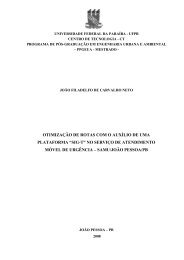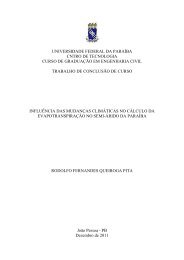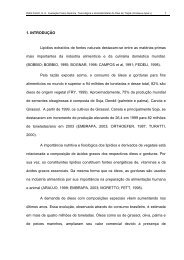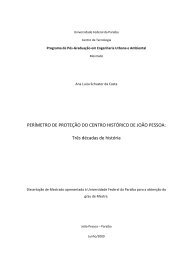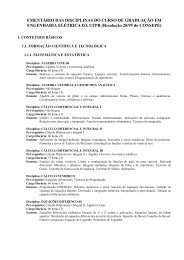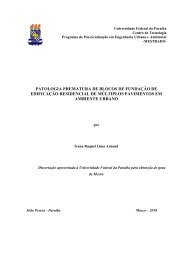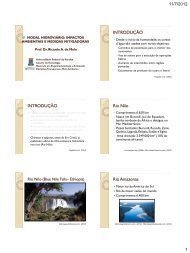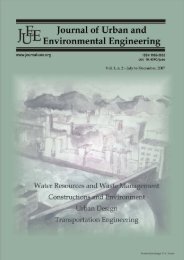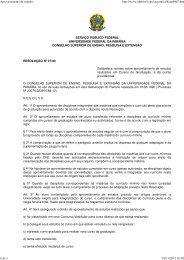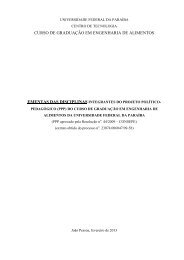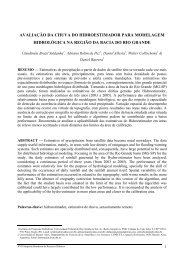editorial team
editorial team
editorial team
You also want an ePaper? Increase the reach of your titles
YUMPU automatically turns print PDFs into web optimized ePapers that Google loves.
42<br />
fluoride adsorption by aluminium compounds follows<br />
the Langmuir-Freundlich adsorption isotherm instead of<br />
the Langmuir isotherm model or Freundlich model.<br />
Generally the defluoridation rate is related to the<br />
aluminium liberation, as follows:<br />
[ ]<br />
-<br />
d⎡F<br />
d Al<br />
-<br />
⎣<br />
⎤<br />
⎦<br />
=φAlqe<br />
dt<br />
dt<br />
tot<br />
Bennajah, Maalmi, Darmane and Touhami<br />
(11)<br />
where φ Al and [Al] tot are the efficiency of hydro-fluoroaluminium<br />
formation and the total aluminium dosage<br />
liberated from the anode, respectively. The rate of Al<br />
liberation from anode can be determined from Faraday’s<br />
law:<br />
d<br />
[ Al]<br />
dt<br />
Tot<br />
I<br />
= φc.<br />
(12)<br />
Z.F.V<br />
where, φ c is the current efficiency, I is the applied<br />
current, Z is the valence of the Al (Z = 3), F is<br />
Faraday’s constant and V is the volume of the reactor.<br />
Combining Eqs (12) and (13) gives:<br />
d<br />
n<br />
−<br />
−<br />
[ F ] q k[ F ] I<br />
φ φ max .<br />
dt Al c<br />
− n<br />
1 + k[ F ] ZFV<br />
= (13)<br />
According to Eq. (14), the pseudo-first-order rate<br />
constant is then deduced and can be expressed as<br />
follows:<br />
k<br />
− n-1<br />
[ F ] I<br />
− n<br />
[ F ] ZFV<br />
qmaxk<br />
= φ<br />
Al<br />
φc<br />
.<br />
(14)<br />
1+<br />
k<br />
The retention time required (t N ) for a targeted<br />
residual fluoride concentration [F - ] e can be determined<br />
by integrating Eq. (15):<br />
t<br />
N<br />
ZFV<br />
=<br />
φφ . I.<br />
q<br />
c Al<br />
( ) 1- n ⎤<br />
0 e ⎥⎦<br />
− − 1 − 1-n −<br />
([ F ] −[ F ] ) + [ F ] −[ F ]<br />
⎡<br />
⎢<br />
⎣<br />
0 e<br />
max<br />
k(1<br />
−n)<br />
Effect of current density:<br />
(15)<br />
The effects of current density and initial fluoride<br />
concentration on the kinetics of the EC process in ALR<br />
are studied below. The initial pH and initial fluoride<br />
concentration were fixed respectively at 7.4 and<br />
15 mg L -1 , i.e. 0.8 mol l -1 .<br />
Figure 3 shows the effect of the current density on<br />
the evolution of the fluoride concentration for the Airlift<br />
reactor.<br />
For I = 0.5 A corresponding to a current density of<br />
2.86 mA cm -2 , the concentration reaches only 4 mg L -1<br />
for an electrolysis time of 30 minutes, whereas, for I<br />
exceeding 2 A (i.e. for a current density higher than<br />
8.6 mA cm -2 ), the concentration reaches a value of<br />
1.5 mg L -1 after 15 minutes and decrease more<br />
especially as the density of current increases.<br />
[F-]mg/L<br />
16<br />
14<br />
12<br />
10<br />
exp 2,86 mA/cm²<br />
exp 5,7mA/cm²<br />
exp 8,6 mA/cm²<br />
exp 11,4 mA/cm²<br />
exp 17,1mA/cm²<br />
model 2,86 mA/cm²<br />
model 5,7 mA/cm²<br />
model 8,6 mA/cm²<br />
model 11,4 mA/cm²<br />
model 17,1 mA/cm²<br />
8<br />
6<br />
4<br />
2<br />
0<br />
0 5 10 15 20 25 30 35<br />
Time min<br />
Fig 3 Evolution of fluoride ions during EC: influence of current intensity (initial pH = 7.4, κ = 7,5 mS cm -1 ) on the ALR : VOK<br />
Model and experiments (n = 1.15, K = 1600, q max = 0.75).<br />
Journal of Urban and Environmental Engineering (JUEE), v.4, n.1, p.36-44, 2010



